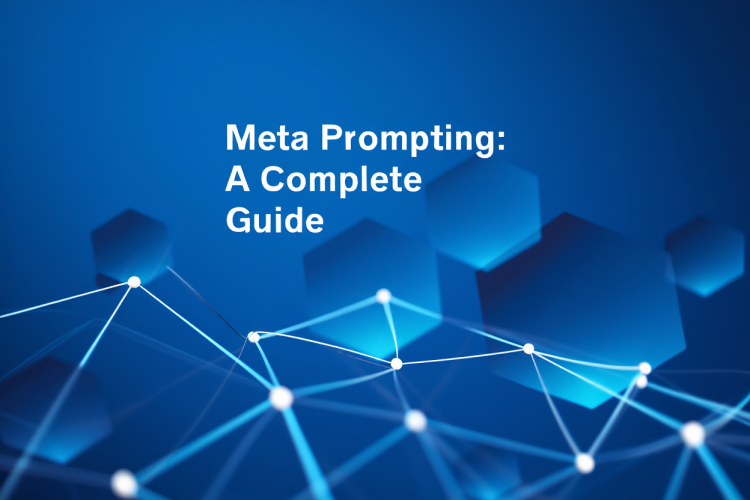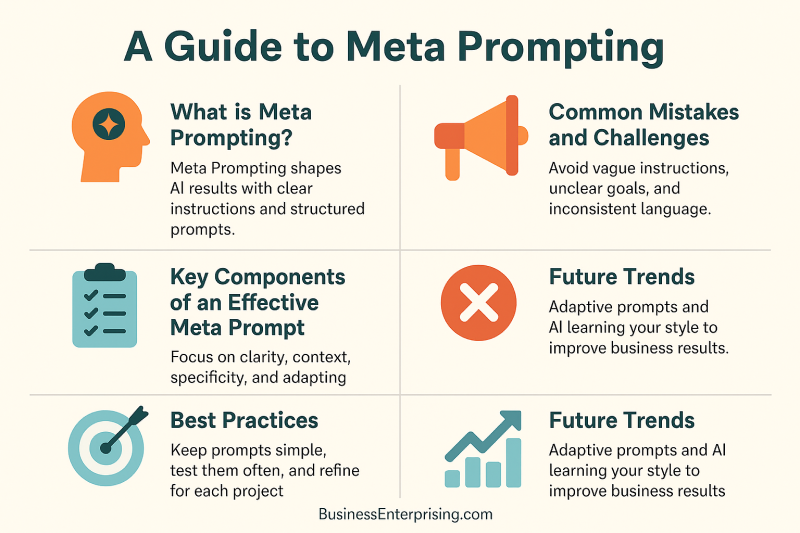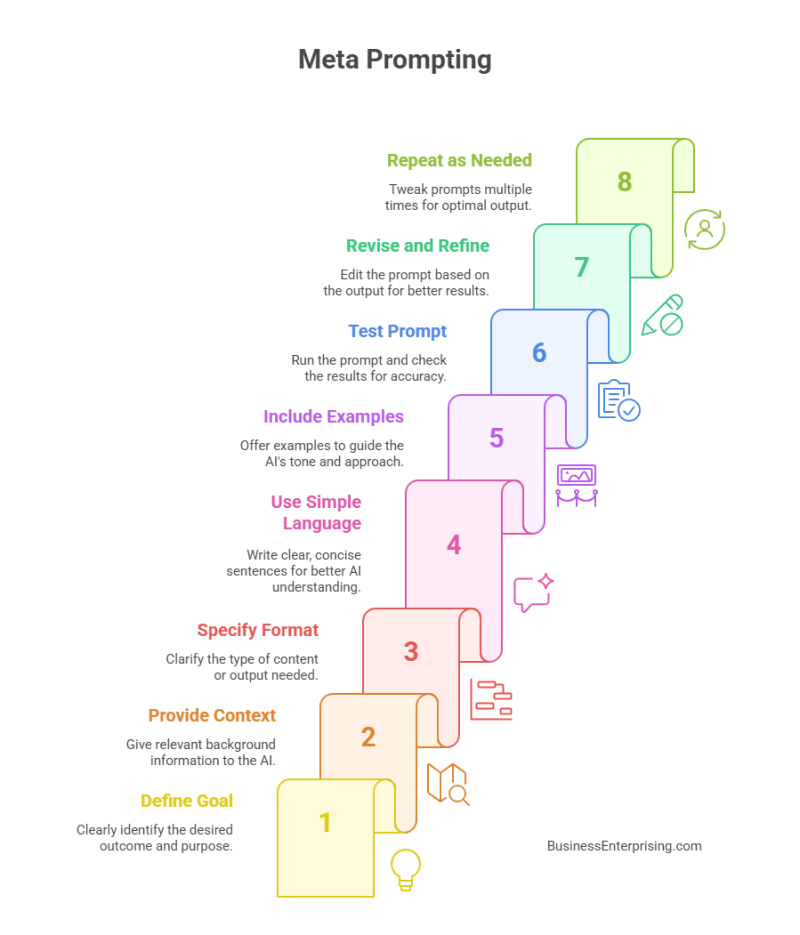 Meta Prompting has become a practical tool for getting better results from your AI projects. It helps you guide the AI’s thinking by crafting prompts that are clear and focused. Therefore, you can get closer to your goal with fewer edits and less wasted time.
Meta Prompting has become a practical tool for getting better results from your AI projects. It helps you guide the AI’s thinking by crafting prompts that are clear and focused. Therefore, you can get closer to your goal with fewer edits and less wasted time.
Additionally, Meta Prompting can help you avoid common mistakes. You don’t have to keep repeating yourself or fixing vague answers. Therefore, it’s an efficient way to get better results in your daily work. However, many people still don’t know how to use it well.
As you learn about meta prompting, you’ll see that it’s more than just a new idea. It’s a skill that can change how you work with AI. Therefore, it pays to understand the basics and practice until it feels natural. Additionally, you’ll notice that small adjustments to your prompts can make a big difference.
However, it’s easy to feel stuck at first. You might wonder how much detail to include or what tone to use. Therefore, starting simple is often the best way to build your confidence. You’ll see that clear and specific instructions almost always bring better results.
As you keep practicing, you’ll find that your AI tasks become easier and faster. Therefore, don’t worry if your first prompts don’t work perfectly. Small changes and careful edits will lead to stronger results over time. Additionally, you’ll build a habit of thinking clearly and being precise.
By understanding the power of Meta Prompting, you’ll see how it can save you time and help your ideas stand out. Therefore, keep testing and refining. This practice will pay off as your AI projects become more focused and effective.
Understanding Meta Prompting: What It Is and Why It Matters
Meta Prompting is an advanced technique in AI that helps you get better results from language models. Instead of relying on basic prompts, you create prompts about prompts. This way, you set up a detailed framework that guides the AI more precisely. By doing so, you can shape the AI’s tone, style, and content to meet your needs.
However, many people overlook how important meta prompting can be. They often think a simple prompt will do the job. But without a solid meta prompt, you might not get the clarity or depth you want. Meta prompting forces you to think ahead and decide exactly what you want. Therefore, it helps you avoid confusion and unnecessary output.
Additionally, meta prompting helps you manage complex tasks. For example, when you’re working on a detailed marketing campaign, you can use meta prompting to craft more relevant and engaging content. It also keeps your AI outputs consistent across projects. This consistency is important for your brand voice and customer messaging.
Furthermore, meta prompting helps you work faster. With clear instructions, the AI spends less time guessing what you mean. As a result, you spend less time editing and adjusting. You also avoid common mistakes and reduce the back-and-forth with your AI tools.
Therefore, learning meta prompting can save you a lot of effort. When you know how to use it, you can produce better work with less stress. Your AI tasks become more predictable, and your results match your goals. This makes your business more productive and your content more effective. Meta Prompting isn’t just a skill. It’s a powerful way to get better work from your AI tools every time you use them.
Key Components of an Effective Meta Prompt
When you start with Meta Prompting, it helps to understand the core parts of a strong prompt. Each part matters because it shapes how well the AI understands what you want. First, focus on clarity. Clear language makes it easier for your AI to figure out exactly what you’re asking. However, vague prompts lead to messy results and frustration.
Context is another key part. Adding context gives your AI a solid foundation. It helps the AI connect your prompt to the right ideas and knowledge. Therefore, always share enough details so the AI has something to work with. Additionally, it makes sure your content stays on point.
Specificity is also very important. Broad prompts can create random or irrelevant output. Therefore, you need to give specific examples, styles, or formats when you can. This guides your AI and keeps it from straying too far. However, you also want to leave enough space for creativity. The balance between detail and flexibility is what makes meta prompting work so well.
Finally, adaptation to the target use case is key. Every project is different, and your prompt should fit the specific task at hand. For example, a blog post outline needs a different prompt structure than a social media caption. Therefore, think about your audience and your goals. Make sure your meta prompt reflects those needs.
When you use all four of these components: clarity, context, specificity, and adaptation you get better results. Your prompts will make your AI a true partner in your work. You’ll also spend less time fixing bad outputs. Meta Prompting works best when you treat it as a skill, not just a quick tool. As you refine these key parts, you’ll see faster, clearer, and more targeted content in your AI projects.
Real-World Applications of Meta Prompting in Business
Meta Prompting has quickly become a practical tool for many businesses. It helps you create AI outputs that match your brand and needs. For example, marketers often use meta prompting to craft email campaigns or ad copy. They rely on it to fine-tune language and keep messages consistent.
However, meta prompting isn’t just for marketing. Sales teams also use it to create detailed customer responses and scripts. Therefore, they save time by using prompts that are already tested and clear. Additionally, it helps keep the tone right, which matters when you’re building relationships.
Research teams also benefit from meta prompting. They use it to summarize data, write reports, or create surveys. It saves them time and avoids confusion. Therefore, they can spend more time analyzing and less time cleaning up rough drafts.
Additionally, meta prompting helps when you want to test different styles or formats. For example, you might want a formal tone for reports and a friendly tone for social media. By adjusting your meta prompts, you get exactly what you need.
However, getting good at meta prompting takes practice. You need to test, learn, and adjust based on your results. Therefore, don’t be afraid to try different ways of phrasing your prompts. You’ll find what works best for your specific use.
As you work with meta prompting, you’ll see that it doesn’t replace creativity. Instead, it helps you bring out your best ideas faster. You stay in control of the message and avoid wasting time. That’s why Meta Prompting has become an everyday tool for busy teams who want smart, reliable results.
Common Mistakes and Challenges in Meta Prompting
When you work with Meta Prompting, it’s easy to make mistakes if you’re not careful. One common issue is giving broad or unclear instructions. Therefore, you might get results that don’t match what you need. Additionally, unclear goals can confuse the AI and slow down your project.
However, you’re not alone in facing these challenges. Many people forget to set clear goals in their meta prompts. As a result, they get content that lacks direction and purpose. Additionally, if you don’t check your prompts for clarity, you’ll end up rewriting everything. That’s not the best use of your time.
Another common mistake is using inconsistent language. If your prompt changes tone too much, the AI might struggle to find the right style. Therefore, it’s important to keep your language simple and direct. This keeps your outputs focused and consistent.
Additionally, you might skip the step of testing your prompts. However, testing is the only way to see what really works. It also shows you how small changes can make a big difference in your results. Therefore, don’t be afraid to refine your prompts after seeing how they perform.
Many businesses also forget that prompts should change with the task. What works for social media might not work for a formal report. Therefore, think carefully about how you want to guide the AI each time you start a new project.
Meta Prompting works best when you stay patient and keep learning. You’ll find that even small edits can improve your results. Therefore, keep refining your prompts so you get content that meets your goals. It’s a skill that grows with practice, and your AI work will show it.
Best Practices for Crafting Powerful Meta Prompts
When you want better AI outputs, focus on crafting powerful meta prompts. Start by being clear about what you want. Therefore, think about your end goal and what kind of content you expect. This step saves you time and avoids confusion later.
However, clarity alone is not enough. You also need context. Provide background information or details that help the AI connect the dots. Therefore, don’t just tell the AI what to do. Tell it why it matters or who it’s for.
Additionally, your prompts should be specific. Vague instructions lead to mixed or unfocused results. Therefore, include examples, formats, or tone preferences. This step helps the AI stay on target and gives you more control.
As you write, keep your language simple and direct. Avoid filler words or unnecessary phrases. Short sentences help the AI process your prompt faster. Additionally, it’s easier for you to see what might need changing later.
After you write your first draft, test it. Testing shows you what’s working and what’s not. Therefore, adjust your prompts based on what you see. Small changes can make a big difference in the final output.
Finally, remember to adapt your meta prompts for each new project. What works for one task may not work for another. Therefore, don’t be afraid to tweak and rewrite as needed.
Meta Prompting is a skill that grows over time. As you practice, you’ll see better results and more consistent outputs. Therefore, keep refining your approach. With each new project, you’ll find ways to make your prompts even more effective.
Future Trends: How Meta Prompting is Shaping the Next Generation of AI
As you work with Meta Prompting, you’ll notice how quickly it’s changing. New tools and ideas are emerging all the time. Therefore, you need to stay up to date if you want to keep up with the latest trends. Additionally, businesses are using meta prompting to get better results from their AI tools.
One trend you’ll see is more adaptive prompts. These prompts adjust to the context and change with the task. Therefore, your AI becomes more flexible and more useful in different situations. Additionally, you’ll see AI models that can work with more complex instructions. This means you can ask for deeper insights or more creative outputs without extra steps.
However, as AI tools get smarter, you’ll also see new ways to guide them. For example, you might use shorter prompts but get more accurate results. Therefore, your workflow becomes faster and more efficient. This saves you time and gives you better results in your business.
Another trend is the rise of AI that learns your style. This means your prompts can get even more tailored to your voice and your goals. Additionally, it makes your AI work feel more like an extension of your team.
However, with new tools and updates, you also need to think about testing your prompts more often. Therefore, treat your prompts like a living tool. Adjust them as your needs change and as AI keeps evolving.
Meta Prompting is not going away. It’s becoming a standard part of how you work with AI. As you learn to use it well, you’ll see how it can boost your productivity. Therefore, keep testing and refining your prompts. You’ll find they can do more than you ever thought possible.
Conclusion
As you continue to work with Meta Prompting, you’ll see how it can shape your results and save you time. Therefore, keep exploring new ways to refine your prompts. This will help you get the most out of your AI tools and keep your work focused.
However, don’t feel you need to get it perfect right away. Like any skill, meta prompting improves with practice. Therefore, start small and build from there. Each project gives you a chance to see what works and what doesn’t.
Additionally, remember that clear goals and context always matter. By using short, direct prompts, you give the AI the best chance to help you. Therefore, think carefully about what you want and write it down in a clear way. This step often makes all the difference.
As you refine your prompts, you’ll also notice that your results improve. The AI will start to understand your needs better and produce work that fits. Therefore, take time to test and tweak your prompts. Small changes often lead to better results.
However, don’t forget to keep your language simple and direct. Fancy words and long sentences only confuse the AI. Therefore, use everyday words and keep your sentences short. This approach helps you and your AI work faster and smarter.
Meta Prompting can help you get the best from your AI tools. It’s not about being perfect or following every rule. It’s about staying open, testing new ideas, and adjusting based on your results. Therefore, keep practicing and refining your prompts. You’ll see how much they can do for your business.



